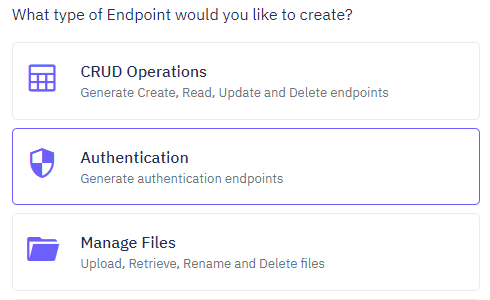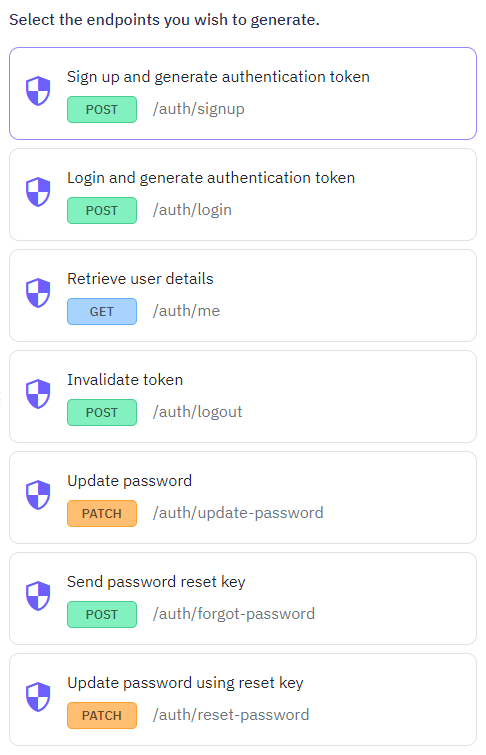-
Follow these steps to create authentication endpoints in Twidget:
Navigate to API Tab:
API tab in your Twidget dashboard.Create New Endpoints:
Create Endpoints button located at the top right corner.
Select Authentication:
Authentication. This will enable various authentication endpoints.
Before creating authentication endpoints, ensure you have an authentication table set up. This table will store all user and authentication data.
Select Authentication Table: Choose the authentication table where user and auth data will be stored.
Set Starting Path: Define the base path you want to prepend to all the endpoints.
Once the authentication option is selected, you will see the following 7 endpoints ready to be generated:
/auth/signup: Endpoint for user signup.
/auth/login: Endpoint for user login.
/auth/me: Retrieve user details.
/auth/logout: Invalidate the current authentication token.
/auth/update-password: Update the user's password.
/auth/forgot-password: Send password reset key via email.
/auth/reset-password: Update the password using the reset key.

Each authentication endpoint comes pre-configured with necessary inputs, outputs, and command steps required to accomplish its task. However, you can edit these configurations as per your requirements.
What is an API
An API (Application Programming Interface) is a set of rules and protocols that allows different software applications to communicate and interact with each other. It defines the methods and data formats that applications can use to request and exchange information, services, or functionalities from...
Create File Endpoints
Overview. Twidget allows you to create file endpoints, which enable you to manage files in your file store. This feature is designed to streamline your workflow by providing predefined endpoints for common file operations. Creating File Endpoints. To create a file endpoint in Twidget, follow these s...
Custom Endpoints
In addition to generating CRUD (Create, Read, Update, Delete), authentication, and file management endpoints, Twidget allows you to create completely custom endpoints from scratch. These custom endpoints give you full control over the various aspects of endpoint configuration, including the inputs, ...
Endpoint Inputs
In Twidget, endpoints have a variety of input types that can be used to configure and execute API requests. These input types include queries, headers, body, files, and path inputs. Each input type serves a specific purpose in allowing users to interact with APIs efficiently. Files. The files input ...
Authentication
Twidget supports Bearer Authentication to ensure secure access to your endpoints. You can specify which endpoints should be secured or open. Once secured, an endpoint can only be accessed using a valid Bearer Token, which is generated via our API. Additionally, we provide functionality to generate a...